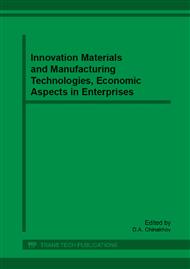p.11
p.16
p.20
p.24
p.28
p.32
p.36
p.43
p.49
Forecasting Residual and Operating Stress in Soldering Cutting Tools with Tungsten-Free Hard Alloy Inserts
Abstract:
The results indicate a reduction of defects in soldering turning tools through optimal dimensions of a solder. In this paper stress in a flat insert is calculated and the results of laboratory tests of cutters iron-carbon soldered are presented. The optimal dimensions of the solder are selected according to calculations conducted
Info:
Periodical:
Pages:
28-31
Citation:
Online since:
August 2013
Authors:
Keywords:
Price:
Сopyright:
© 2013 Trans Tech Publications Ltd. All Rights Reserved
Share:
Citation:


